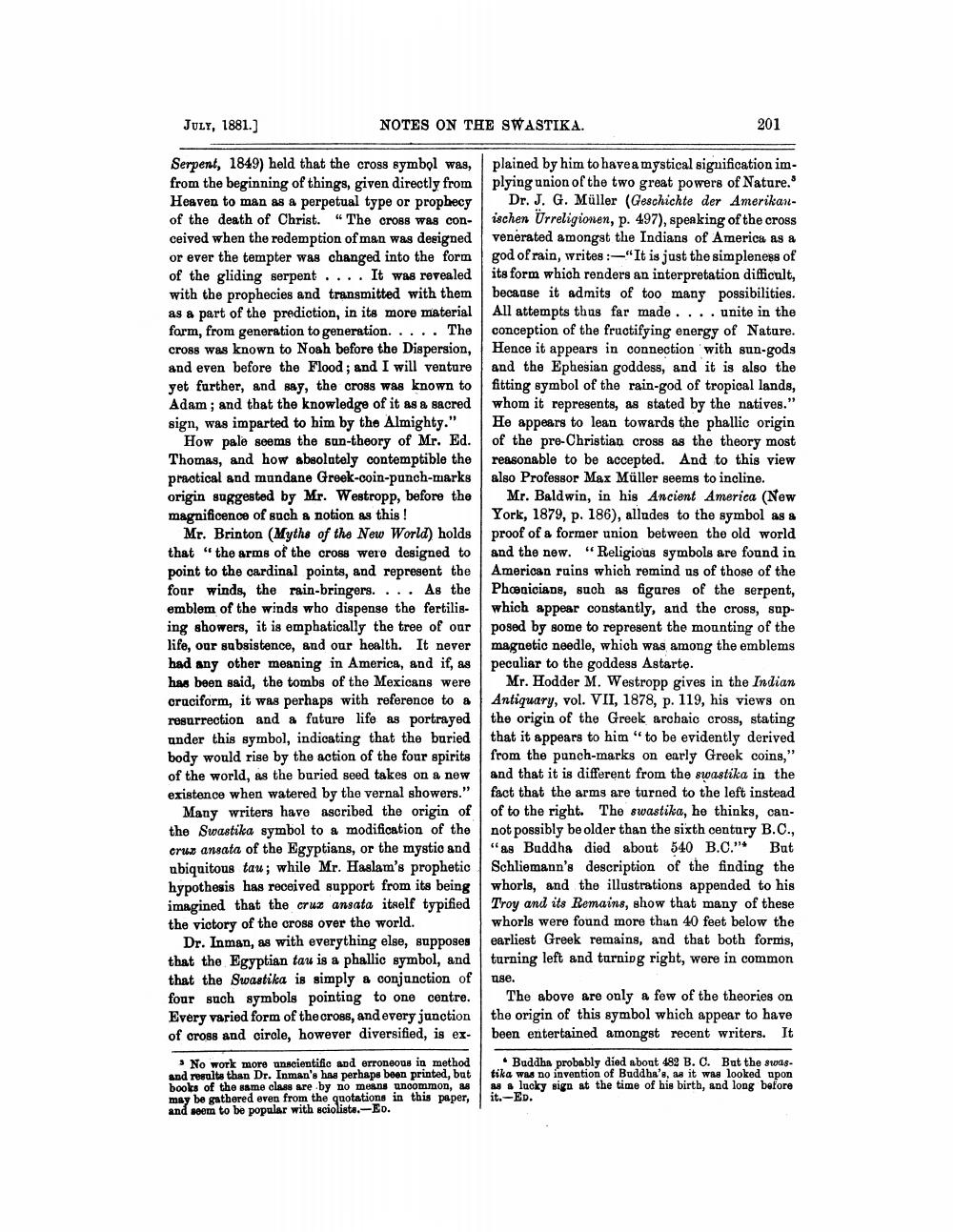________________
JULY, 1881.)
NOTES ON THE SWASTIKA.
201
Serpent, 1849) held that the cross symbol was, from the beginning of things, given directly from Heaven to man as a perpetual type or prophecy of the death of Christ. “The cross was con- ceived when the redemption of man was designed or ever the tempter was changed into the form of the gliding serpent .... It was revealed with the prophecies and transmitted with them as a part of the prediction, in its more material form, from generation to generation. .... The cross was known to Noah before the Dispersion, and even before the Flood; and I will venture yet farther, and say, the cross was known to Adam; and that the knowledge of it as a sacred sign, was imparted to him by the Almighty."
How pale seems the sun-theory of Mr. Ed. Thomas, and how absolutely contemptible the practical and mundane Greek-coin-punch-marks origin suggested by Mr. Westropp, before the magnificence of such a notion as this !
Mr. Brinton (Myths of the New World) holds that "the arms of the cross were designed to point to the cardinal points, and represent the four winds, the rain-bringers. ... As the emblem of the winds who dispense the fertiliging showers, it is emphatically the tree of our life, our subsistence, and our health. It never had any other meaning in America, and if, as has been said, the tombs of the Mexicans were cruciform, it was perhaps with reference to a resurrection and a future life as portrayed under this symbol, indicating that the buried body would rise by the action of the four spirits of the world, as the buried seed takes on a new existence when watered by the vernal showers."
Many writers have ascribed the origin of the Swastika symbol to a modification of the crud ansata of the Egyptians, or the mystio and ubiquitous tau; while Mr. Haslam's prophetic hypothesis has received support from its being imagined that the cruz ansata itself typified the victory of the cross over the world.
Dr. Inman, as with everything else, supposes that the Egyptian tau is a phallic symbol, and that the Swastika is simply a conjunction of four such symbols pointing to one centre. Every varied form of the cross, and every junction of cross and circle, however diversified, is ex
plained by him to havea mystical signification implying union of the two great powers of Nature,
Dr. J. G. Müller (Geschichte der Amerikanischen Urreligionen, p. 497), speaking of the cross venerated amongst the Indians of America as a god of rain, writes :-"It is just the simpleness of its form which renders an interpretation difficult, because it admits of too many possibilities. All attempts thus far made . . . . unite in the conception of the fructifying energy of Nature. Hence it appears in connection with sun-gods and the Ephesian goddess, and it is also the fitting symbol of the rain-god of tropical lands, whom it represents, as stated by the natives." He appears to lean towards the phallic origin of the pre-Christian cross as the theory most reasonable to be accepted. And to this view also Professor Max Müller seems to incline.
Mr. Baldwin, in his Ancient America (New York, 1879, p. 186), alludes to the symbol as a proof of a former union between the old world and the new. "Religions symbols are found in American rains which remind us of those of the Phoenicians, such as figures of the serpent, which appear constantly, and the cross, sopposed by some to represent the mounting of the magnetic needle, which was among the emblems peculiar to the goddess Astarte.
Mr. Hodder M. Westropp gives in the Indian Antiquary, vol. VII, 1878, p. 119, his views on the origin of the Greek archaic cross, stating that it appears to him "to be evidently derived from the punch-marks on early Greek coins," and that it is different from the swastika in the fact that the arms are turned to the left instead of to the right. The swastika, he thinks, cannot possibly be older than the sixth century B.C.,
as Buddha died about 540 B.C." Bat Schliemann's description of the finding the whorls, and the illustrations appended to his
Troy and its Remains, show that many of these whorls were found more than 40 feet below the earliest Greek remains, and that both forms, turning left and turning right, were in common ase.
The above are only a few of the theories on the origin of this symbol which appear to have been entertained amongst recent writers. It
No work more unscientific and erroneous in method and results than Dr. Inman's has perhaps been printed, but
Buddha probably died about 482 B. C. But the swastika was no invention of Buddha's, as it was looked upon as a lucky sign at the time of his birth, and long before it.-ED.
may be gathered even from the quotations in this paper, and seem to be popular with scioliste.-E.




